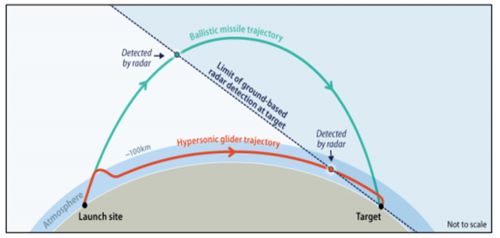Context
The landscape of warfare is undergoing a rapid transformation, largely driven by technological advancements. Technologies such as Artificial Intelligence (AI) and drones are increasingly shaping the dynamics of modern warfare, as evidenced by recent conflicts such as the Ukraine War and the Israel-Hamas conflict. Among these innovations, hypersonic weapons have emerged as a particularly disruptive force, with implications for future military strategies.
Definition and Types of Hypersonic Weapons
Hypersonic weapons are defined as those that travel at speeds exceeding Mach 5, or five times the speed of sound (330 m/s). There are two main types: Hypersonic glide vehicles (HGV) and Hypersonic cruise missiles. HGVs are launched from rockets and glide to their targets, while hypersonic cruise missiles are propelled by air-breathing engines throughout their flight. These weapons possess extraordinary speed, maneuverability, and the ability to carry both conventional and nuclear warheads.
The proliferation of hypersonic weapons presents formidable challenges for traditional defense systems. They can evade detection by terrestrial-based radars until late in their flight, rendering existing defenses inadequate. Moreover, their ability to carry both conventional and nuclear payloads escalates their threat level.
Global Initiatives and Progress
Several nations, including Australia, India, France, Germany, South Korea, North Korea, and Japan, are actively engaged in developing hypersonic weapon technology. However, the United States, China, and Russia have made the most significant strides in this field. This progress is attributed partly to the US withdrawal from the Anti-Ballistic Missile Treaty in 2001, raising concerns about its ability to intercept incoming missiles.
The United States
The United States has been actively pursuing hypersonic weapon development through various programs across different branches of its military:
1. Conventional Prompt Strike (CPS)
Department: US Navy
Details: Despite initial setbacks, the US Navy's CPS program aims to deploy hypersonic weapons on submarines and destroyers by 2025.
2. Hypersonic Air-Launched OASuW (HALO)
Department: US Navy
Details: The HALO program, compatible with F/A-18 fighter jets, demonstrates the Navy's commitment to air-launched hypersonic capabilities.
3. AGM-183 Air-Launched Rapid Response Weapon (ARRW)
Department: US Air Force
Details: While facing challenges, the ARRW program has shown promise, with recent tests potentially revitalizing interest in its development.
4. Hypersonic Attack Cruise Missile (HCAM)
Department: US Air Force
Details: Another initiative by the USAF, the HCAM program underscores the importance of hypersonic capabilities in aerial warfare.
China
China has made significant strides in hypersonic technology, with several successful tests and operational deployments:
1. DF-17
Details: The DF-17, a medium-range ballistic missile, demonstrates China's capability to deploy hypersonic glide vehicles with impressive range.
2. DF-41
Details: The DF-41 ICBM, potentially armed with hypersonic payloads, poses a formidable threat due to its long-range capabilities.
3. DF-ZF
Details: China's DF-ZF HGV, fielded in 2020, showcases the country's advancements in hypersonic technology.
Russia
Russia has been at the forefront of hypersonic weapon development, with operational deployments and ongoing programs:
1. Avangard
Details: The Avangard HGV, deployed in 2019, represents Russia's advancement in hypersonic missile technology.
2. 3M22 Tsirkon
Details: The 3M22 Tsirkon, a ship-launched hypersonic cruise missile, enhances Russia's naval capabilities with its speed and maneuverability.
India's Progress
India has been actively pursuing hypersonic technology development through initiatives such as the BrahMos-II missile and the Hypersonic Technology Demonstrator Vehicle (HSTDV):
1. BrahMos Aerospace
Details: The BrahMos-II missile, modeled after the Russian Tsirkon, aims to enhance India's hypersonic capabilities.
2. Defence Research and Development Organisation (DRDO)
Details: The DRDO's HSTDV project, successfully tested multiple times, demonstrates India's progress in hypersonic technology.
India's Hypersonic Test Facility
India recently inaugurated its first hypersonic test facility at IIT Kanpur, funded by the DRDO and other agencies. This facility enables the simulation of hypersonic conditions for various defense projects, including the BrahMos-II program.
The Necessity for Hypersonic Deterrence
Hypersonic weapons pose significant challenges due to their speed, maneuverability, and stealth capabilities. Traditional defense systems struggle to detect and intercept hypersonic threats effectively, making them a potent tool in modern warfare.
While India has made strides in hypersonic technology development, there is a need for greater emphasis on hypersonic defense:
1. DRDO's Ballistic Missile Defense (BMD) Program
Details: India's BMD program, though progressing, should incorporate hypersonic defense capabilities to counter emerging threats effectively.
2. Role of Indian Space Research Organisation (ISRO)
Details: ISRO can play a crucial role in developing space-based sensors similar to those envisioned by the US SDA, enhancing India's ability to detect and track hypersonic threats.
Conclusion
India stands at a critical juncture in its pursuit of hypersonic capabilities and deterrence strategies. As hypersonic weapons redefine the dynamics of modern warfare, India must prioritize the development of both offensive and defensive capabilities to maintain its strategic interests and national security. By leveraging its technological prowess and fostering collaborations with international partners, India can emerge as a significant player in the hypersonic arms race, ensuring stability and security in the region.
|
Probable Questions for UPSC Mains Exam- 1. Discuss the significance of hypersonic weapons in modern warfare, considering their characteristics, challenges posed to traditional defense systems, and the implications for global security. Provide examples from major players in hypersonic technology development. 2. Evaluate India's progress in the development of hypersonic weapons and deterrence strategies. Analyze the initiatives undertaken by the Indian government, the role of defense organizations such as DRDO and ISRO, and the challenges and opportunities for India in the hypersonic arms race. |
Source- ORF







